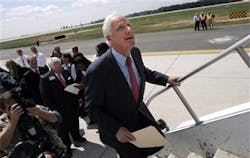Atlanta Toasts Airport's Fifth Runway
Minutes before a Delta Air Lines 767 christened Hartsfield-Jackson International Airport's fifth runway with its first set of skid marks, Delta CEO Gerald Grinstein commandeered the plane's public-address system.
"This is a very short journey to a long-awaited new runway," he told his fellow passengers Tuesday.
Runway 10/28, better known as "the fifth runway," is a $1.28 billion slab of concrete that spans I-285 and is expected to reduce delays at Hartsfield-Jackson by boosting its capacity to handle flights.
City, local and federal officials held a celebration Tuesday for about 800 visitors, and Delta and AirTran Airways whisked dignitaries on 30-minute scenic rides that ended in soft touchdowns on the runway that took 20 years to design, fund and build.
Visitors sipped champagne on the concrete surface, which opens for regular operations May 27. They ate from a taxiway buffet that included bagels, French toast, tables with fresh-cut flowers and a massive cake sculpted in the shape of the new runway.
About two dozen flight attendants from various airlines formed a greeting line, and the Tri-Cities High School orchestra from south Fulton County played classical music that competed with the roar of jets taking off less than a mile away.
Hartsfield-Jackson General Manager Ben DeCosta said the pomp and ceremony was appropriate for the conclusion of a massive engineering feat that took a generation to complete.
"We've worked so hard all these years. This is a victory for all of us," DeCosta said.
Atlanta Mayor Shirley Franklin praised the city's Department of Aviation, which she said "has stayed the course."
DeCosta alluded to a financial scandal during former Mayor Bill Campbell's administration in which an airport contractor pleaded guilty to attempting to bribe Campbell to win a lucrative dirt-moving contract. DeCosta said "a tangle of political issues could have stopped this runway in its tracks," but he credited Franklin for keeping the project moving ahead.
"If not for Shirley Franklin and her leadership, this runway would open in 2009 instead of 2006," DeCosta said.
Federal Aviation Administration chief Marion Blakey also spoke.
When it becomes fully operational, the fifth runway will be used mainly for landings. Hartsfield-Jackson's runways are all parallel and far enough apart that controllers will be able to land planes on three runways while using two for takeoffs. The airport's peak-hours capacity will rise to 135 arrivals per hour vs. about 100 now.
The downside: Planes landing on the new runway must taxi about two miles and cross two active runways to reach the gates --- a process expected to take longer than usual, at least 15 minutes.
The fifth runway will only be used for landings in good weather until new aeronautical charts are distributed worldwide June 8. A new air control tower --- at 398 feet the tallest in North America --- recently opened to give controllers an adequate view of the new runway.
One of the biggest public construction projects in Georgia history, the fifth runway was finished on time and within budget, according to officials. It was paid for through a mix of bonds, passenger fees and federal allotments.
Four Georgia Domes' worth of dirt was moved to the site via conveyor belt to build a foundation. The runway's eastern end consists of a bridge across I-285, creating a 1,500-foot tunnel for motorists --- the longest of its kind in the world.
The runway is one element of Hartsfield-Jackson's overall $6 billion expansion plan, which also includes a new rental car complex connected to the terminal by a monorail. A planned international terminal to the east of the existing gate concourses is well behind schedule and will not open before 2010 at the earliest. An eventual south terminal would provide easier access for airplanes using the fifth runway.
But completion of the runway marks an end, too.
John Boatright, a former Delta executive hired as an airport consultant to oversee the construction project, said he plans to leave when his contract expires this summer.
"My primary motivation was to make this runway happen," he said. "Logistical nightmares that need solutions are just problems that need to be solved --- and that's fun for me. I like seeing all the pieces come together. It's dynamic, it's interesting, and that's what happened with this project."
Delta's chief pilot, Jim Graham, and colleague Kevin Mathison were at the controls of the 767 that made the inaugural flight Tuesday.
Mathison told cheering passengers just before takeoff that their plane --- dubbed Flight 1028 to match the runway's numerical designation --- was "No. 1 for the runway, of course."
News stories provided by third parties are not edited by "Site Publication" staff. For suggestions and comments, please click the Contact link at the bottom of this page.

